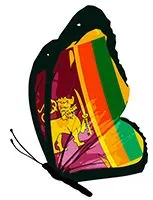 Taaffeite is a beryllium magnesium aluminum oxide, which is very rare and resembles spinel in color. Because of this resemblance, it was actually cut as a spinel gemstone before it was identified as a new mineral. This is a very rare and unique occurrence in the world of gemology.
Taaffeite is a beryllium magnesium aluminum oxide, which is very rare and resembles spinel in color. Because of this resemblance, it was actually cut as a spinel gemstone before it was identified as a new mineral. This is a very rare and unique occurrence in the world of gemology.
 Taaffeite was first discovered by accident in 1946 by Count Taaffe of Dublin, Ireland. The Count actually picked up the stone from the waste in a colleague's work space, and recognized that the gem was doubly refractive. While the gem looked like spinel, this double refractive quality was a hint to the Count, that he had stumbled upon something special, as spinel is only singly refractive. Because Count Taaffe did not have the chance to investigate the stone himself, he sent the sample to the London Gemstone Testing Laboratory and then to the Natural History Museum for analysis. At the Natural History Museum, a small slice was taken off the stone for x-ray analysis. It was at this time that the stone was recognized as a new, unclassified mineral, and was named after its discoverer.
Taaffeite was first discovered by accident in 1946 by Count Taaffe of Dublin, Ireland. The Count actually picked up the stone from the waste in a colleague's work space, and recognized that the gem was doubly refractive. While the gem looked like spinel, this double refractive quality was a hint to the Count, that he had stumbled upon something special, as spinel is only singly refractive. Because Count Taaffe did not have the chance to investigate the stone himself, he sent the sample to the London Gemstone Testing Laboratory and then to the Natural History Museum for analysis. At the Natural History Museum, a small slice was taken off the stone for x-ray analysis. It was at this time that the stone was recognized as a new, unclassified mineral, and was named after its discoverer.
 For the next thirty years, only two pieces of taaffeite were in circulation. At the time, it was considered one of the most rare minerals in the world. Since that time, however, many more taaffeite specimen have been found in a variety of different colors. The heaviest cut piece of taaffeite is 12.5 carats. Taaffeite is a fairly hard stone, rating an 8 on the hardness scale. It has a vitreous luster and is commonly given a cushion or brilliant cut. Taaffeite comes in a wide range of colors, from pale mauve, rose red and
For the next thirty years, only two pieces of taaffeite were in circulation. At the time, it was considered one of the most rare minerals in the world. Since that time, however, many more taaffeite specimen have been found in a variety of different colors. The heaviest cut piece of taaffeite is 12.5 carats. Taaffeite is a fairly hard stone, rating an 8 on the hardness scale. It has a vitreous luster and is commonly given a cushion or brilliant cut. Taaffeite comes in a wide range of colors, from pale mauve, rose red and ![]() ruby-red, to violet,
ruby-red, to violet, ![]() sapphire, gray-blue, pure blue, chestnut, and almost colorless.
sapphire, gray-blue, pure blue, chestnut, and almost colorless.
 There are no imitations of taaffeite. The stone is found mainly in Sri Lanka, which has been the main supplier of the stone since the mid 70's. Taaffeite can also be found in Myanmar, China, and the former USSR.
There are no imitations of taaffeite. The stone is found mainly in Sri Lanka, which has been the main supplier of the stone since the mid 70's. Taaffeite can also be found in Myanmar, China, and the former USSR.